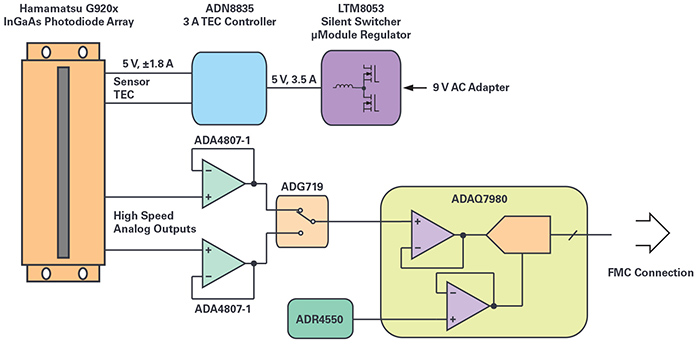Integration and collaboration - the heart of image sensor reference design
Scott Hunt, System Application Engineer at Analog Devices (ADI), discusses the factors at the heart of a high performance image sensor reference design.
Image sensing in dispersive spectroscopy applications requires a linear array image sensor with very low noise and a high bit rate for high sensitivity and high speed measurements. In order to reduce the detector dark noise and further increase the sensitivity of the measurement, a thermoelectric cooler (TEC) is required. These requirements also demand high performance electronics to interface with the sensor. The sensor readout requires low noise and fast settling amplifiers and a low noise, precision analogue-to-digital converter (ADC).
The TEC requires precision current control and voltage limiting in order to precisely control the temperature. Power management electronics must be capable of delivering the high power required by the TEC, as well as the low noise required by the readout circuitry. Finally, a good printed circuit board layout is critical to avoid magnetically or conductively coupled interference of the high power switching signals with the precision readout electronics.
Designing a system with discrete electronic components to interface with these complex and high performance sensors has been a challenge in the past, requiring a careful trade off of size and complexity vs. performance. Hamamatsu Photonics and Analog Devices, saw this as an opportunity to combine their expertise to create a reference design for the Hamamatsu G920x InGaAs linear image sensor family, where Hamamatsu provided the sensor and system components and Analog Devices designed the analogue front-end (AFE) board.
This reference design allows modular evaluation by interfacing to FPGA carrier cards via an FMC connector. Analog Devices’ µModule regulators are used to provide a compact, optimal layout for the most challenging layout portions of the design. For example, the LTM8053 µModule buck regulator integrates the magnetic components with an internal layout that greatly reduces electromagnetic noise. By providing a compact and optimised layout and reducing the component count, these highly integrated products also enable a smaller solution without trading off performance.
Three key highly integrated products enable this compact and high performance AFE design:
- The ADAQ7980 is a single-chip, high performance, 16-bit, 1 MSPS SAR ADC data acquisition system module. The ADAQ7980 features a high precision SAR ADC with an integrated ADC driver, a reference buffer, an LDO regulator, and integrated precision passives and decoupling components.
- The ADN8835 is a precision TEC controller with integrated 3A power FETs. The ADN8835 precisely controls the temperature of the sensor without requiring external discrete power FETs.
- The LTM8053 is an ultralow noise 3.5A Silent Switcher µModule buck switching regulator. The LTM8053 integrates the switching controller, power switches, inductor, and all support components into a compact package laid out for optimal noise performance.
These products demonstrate key characteristics of Analog Devices’ highly integrated products, which include reducing BOM complexity and board space, performance optimisation by eliminating board level parasitics in critical circuits, and reducing system errors and uncertainty by providing performance specifications that encompass more of the signal chain. Additional high performance Analog Devices components are used to complete the AFE solution, including the ADR4550 precision voltage reference and the ADA4807 high speed precision amplifier. The AFE also provides the capability to synchronise the clocks of the LTM8053 and ADN8835 with the sampling clock that is provided to the sensor and ADAQ7980.

Above: Figure 1. Simplified block diagram of image sensor reference design
In summary, Analog Devices has partnered with Hamamatsu Photonics. to develop a high performance reference design for sensors in the Hamamatsu G920x linear array NIR/SWIR InGaAs image sensor family. These linear array InGaAs image sensors have a high readout speed and include an integrated TEC to cool the optical detectors for extremely low noise operation. This makes them well suited for high performance NIR/SWIR spectroscopy applications such as gas and mineral identification.
An Analog Devices AFE board has been developed to interface to these sensors, featuring high performance and compact size enabled by Analog Devices’ integrated products.



